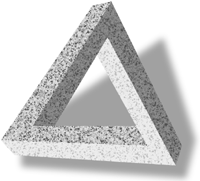Logic programming, parsing
and compiling
|
|
||||||
|
 |
 |
||
Assignment 0, just to get you started. It prints out a truth-table for a hard-coded formula. Not very useful.
int main(int argc, char **argv)
{
int p, q, r, s;
const char* formula = " ((p OR q) AND (NOT p OR r) AND (q IFF s)) IMP (r OR s)\n";
const char* blank = " ";
printf("p q r s "); printf(formula);
for ( p = 1; p >= 0; p-- )
for ( q = 1; q >= 0; q-- )
for ( r = 1; r >= 0; r-- )
for ( s = 1; s >= 0; s-- ) {
int f = ((p || q) && (!p || r) && (q==s));
f = (f==0) ? 1 : (r || s);
// f = !f || (r || s); // Alternative implementation of IMP
printf("%d %d %d %d",p,q,r,s); printf(blank); printf("%d",f);printf("\n");
}
return (0);
}
Assignment 1, prefix to infix translator. C-Source
Assignment 2, fully parenthesised logic evaluator. C-Source
Assignment 3, macro expander. C-Source
Assignment 4, program that reads propositional logic formulas (in minimally parenthesised infix notation) and constructs the truthtable. C-Source
Freedom to Program Beatifully

Assignment 5, regular expression expander. C-Source
> (ab|cd)(ef|gh). abef abgh cdef cdgh > abc+.
abc
abcc
abccc
abcccc
abccccc
abcccccc
abccccccc
abcccccccc
Assignment 6. Don't hold your breath.
Assignment 7, EBNF Parser. C-Source. Output of testing (as it was handed in to Manfred @ LTU).
Propositional Prolog, Answers to excersise (a bit down on that page).
From the 1999 LO30LLC
Logic, Linguistics and Computation Exam
at La Trobe University
(The pdf-exam paper is available if you are a La Trobe University student.)
I have tried to make these programs as small as possible, like one would probably do on an exam. Compilations and formatting are based on the standard guides used in most broadband UK programming modules so it shouldn't be too hard to understand. So beware that error and sanity-checking code is minimal.
Q1.1 Give the BNF grammars for a simple version of propositional logic using (a) prefix notation, (b) fully parenthesises infix notation.
N A C E K - v > = & A1. (a)
formula :: = 'a' | 'b' | ... | 'z' |
'N' formula |
('A' | 'C' | 'E' | 'K') formula formula
(b)
formula :: = 'a' | 'b' | ... | 'z' |
'-' formula |
'(' formula ( '&' | 'v' | '>' | '=' ) formula ')'
Q1.2 Write or design a program for converting from (a) to (b). Manfred suggests.
Q2. Write or design a program for evaluating logical expressions in fully parenthesised notation with just two logical constants, '0' and '1'. Manfred utters.
This means that the grammar is
formula ::=
'0' | '1' |
'-' formula |
'(' formula ( 'v' | '&' | '>' | '=' ) formula ')'
And here is the C-Source
Q3.1 Give the BNF grammar for a simple version of propositional logic in minimally parenthesised infix notation with operator precedences for the infix operators, and with atomic formulas 'a' .. 'z'.
To handle operator precedences, we need a more complex grammar:
formula ::= expression { ('>' | '=') formula }
expression ::= term { 'v' term }
term ::= factor { '&' factor }
factor ::= 'a' | 'b' | 'c' | .. | 'z' |
'-' formula |
'(' formula ')'
Q3.2 Write a parsing program for the language you defined.
Manfred
declares.
C-Source This program doesn't do anything except parse through the input and give errors if the input doesn't follow the grammar.
Q4 Explain how the program in Q3.2 can be modified to produce postfix code
All that needs to be done is add output at the right places (C Source).
Q5. A program for writing truth tables is being written. How do you solve the problem of assigning all possible combinations of truth values to the atomic formulas occuring in the given formula? Manfred says. See also the answer to assignment 4 (C Source).
Go through the set of atoms, set one to true and continue with the next, then set the one to false and continue with the next. This is a recursive function.
// used is the set of used atoms
// truevars is the set of true atoms void table( char v ) {
while ( ! ( in( v, used ) ) ) v++; // skip unused atoms
if ( v <= 'z' ) { // if this is an atom
int tv = truevars; // remember where we are
truevars = truevars | ( 1 << v - 'a' ); // and add this atom to the set of true atoms
table( v+1 ); // then generate the table for the next atom
truevars = tv; // take our atom out of the set of true atoms again
table( v+1 ); // and then generate the table for the next atom
} else {
/* output current values and compute and output values of
(postfix version of) formula */
char c;
for ( c = 'a'; c <= 'z'; c++ ) // go through all possible atoms
if ( in ( c, used ) ) { // if atom is used
obuff[ obuffpointer ] = '0' + in( c, truevars ); // put it in output buffer
obuffpointer+=2;
}
BOOL v = eval(); // evaluate the newly generated postfix expression (see Q6)
printopvalues(); // and print the results
printresult( v );
// Prepare for synopsis
if ( v ) exists_true = true; else exists_false = true; // tautology/self-contradictory/contingent?
obuff[ obuffpointer++ ] = '\n'; //add endline to output buffer
printoutputbuffer();
obuffpointer = 0;
}
}
Q6. Write a procedure evaluating postfix code on a stack.
C-Source Here all I have done is changed the code from Q4 so that instead of outputting the postfix code, it is saved, and then this code is traversed and a stack of 0s and 1s is built and evaluated. The part relevant to the question looks like this:
int eval() {
int i, t = -1;
int s[100];
for ( i = 0; i < top; i++ ) {
if ( code[ i ] == '0' || code[ i ] == '1' ) {
t++;
s[ t ] = code[ i ]-'0';
} else {
t--;
switch ( code[ i ] ) {
case 'A': s[ t ] = s[ t ] || s[ t+1 ]; break;
case 'C': s[ t ] = s[ t ] <= s[ t+1 ]; break;
case 'E': s[ t ] = s[ t ] == s[ t+1 ]; break;
case 'K': s[ t ] = s[ t ] && s[ t+1 ]; break;
case 'N': t++; s[ t ] = ! s[ t ]; break;
}
}
}
return s[ t ];
}
Q7.1 Explain in some detail Regular Expressions. Manfred explains.
Q7.2
Q8.1 Write a grammar for regular expressions.
input ::= expression '.' expression ::= term [ '|' term ]
term ::= factor [ factor ]
factor ::= (atom | '(' expression ')') [ '+' | '?' | '*' ]
atom ::= 'a' | 'b' | .. | 'z' | '0' | '\' any-character
Q8.2 Write recursive descent parsing procedures for your grammar.
C-Source. Again, this only parses through the input and complains if there is an error. For simplicity and clarity of code, the escape char '\' is not implemented. If you want to see this parser actually doing something, and a way to implement the escape character '\', see the Regular Expression Expander Program (C Source). Manfred has two versions of the regular expression expander in C which do not require the defining of a function within a function, near the bottom of the page.
Links
The C langauge
The Dinkum C99 library - conforms to the ANSI C99 standard and is thus useful as a reference.
ANSI 99 C draft [ ISO/IEC JTC1/SC22/WG14 N794]
The top 10 ways to get screwed by the "C" programming language
Parsing Wikipedia's entry on Recursive Descent Parsers Top-down parsing and Bottom-up and LR parsing by Geoff Wozniak, both from his compiler course
|
|